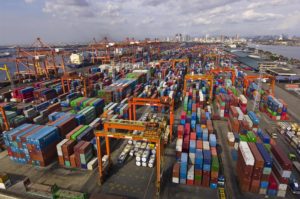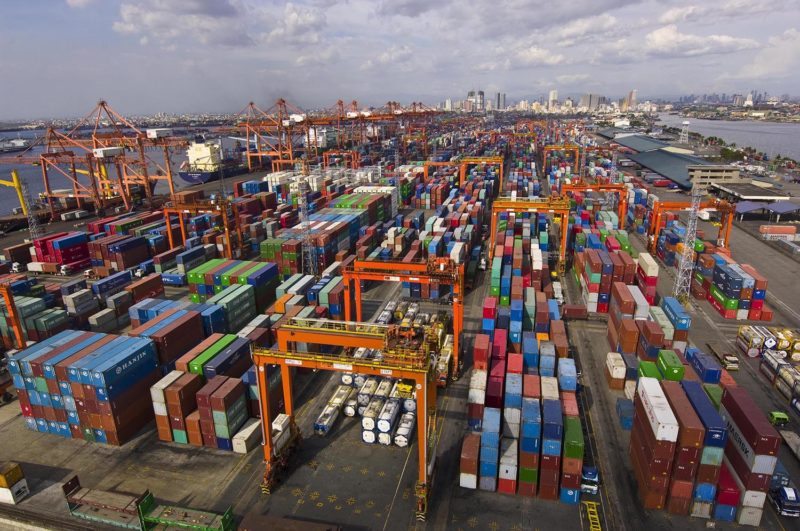
The Manila International Container Terminal (MICT) continues to perform optimally as it gears up for the peak season, according to operator International Container Terminal Services, Inc. (ICTSI).
Yard utilization in May was at 61%, below the ideal 70%. During the same month, average crane productivity hovered at 32 moves per hour. These numbers, ICTSI said, underscore the terminal’s strong performance despite higher container volume due to a rebound in global trade.
In a statement, ICTSI senior vice president and head of Asia Pacific region and MICT Christian R. Gonzalez described MICT’s yard utilization as “optimal”, noting that “the mechanisms we developed together with the Philippine government and other stakeholders in 2014 continue to work, resulting in the easing of traffic in Metro Manila despite inadequate trade infrastructure.
“Global container traffic is slowly recovering. As a matter of fact, Southeast Asia and North America have posted the highest average growth at seven percent during the final quarter of last year. While we remain optimistic that this trend will continue, I am confident that we will be able to keep up with the pace and accommodate the projected increase.”
Last year, MICT achieved a milestone with its first year-to-date two-millionth twenty-foot equivalent units (TEU) move, triggering a multi-billion peso capacity improvement commitment with the Philippine Ports Authority that requires ICTSI to commission five neo-Panamax quay cranes and 12 reach stackers, and build two new berths by 2020. The expansion and capacity improvement will enable MICT to service bigger ships, now becoming the trend in global container trade, ICTSI said.
“We are entering the era of larger ships. We need to adapt and stay competitive by enhancing our capabilities, which is something that we have already started,” Gonzalez said.
In a chance interview on July 4, Gonzalez said three of the new quay cranes will arrive February of next year and the other two in 2019.
Due to the trend in deployment of bigger ships that requires more cranes and deeper drafts, Gonzalez said ICTSI will soon start dredging to achieve at least a 13.5-meter draft for MICT.
Entering the second half of the year, ICTSI said volume is expected to surge, with imports starting to arrive ahead of the holiday season. Historical data from the PPA also show consistent MICT volume growth since 2015, with productivity and utilization staying proportionally healthy all throughout.
“Port congestion is a challenge every major and busy port in the world has to contend with,” he said.
Yangshan Port in Shanghai, for instance, encountered congestion similar to what Manila ports suffered in 2014, albeit owing to different causes: adverse weather conditions, a shift in shipping alliances, and higher-than-usual volumes, Gonzalez observed. In April, the queue outside Yangshan port reached up to 100 ships as the average waiting time at the berth reached 18.2 hours.
“In 2014, the root cause of the (Manila) port congestion was the truck ban that limited truck movement in the city’s major thoroughfares. We simply couldn’t get the containers out of the terminal. Unlike the situation in Yangshan, our problem back then was something we could control. We needed to think outside of the dock – and that’s how we came up with the Terminal Appointment Booking System (TABS). We looked for a solution to the problem outside the port,” he said.
“The congestion problem in the Port of Manila in 2014 provided us with the opportunity to further improve our operations at the MICT. We resolved the issue by putting in place new technologies that would not only upgrade the terminal, but would make MICT a sustainable business factoring in the quality of life of our hinterland communities and immediate environs. We’ve engaged all port stakeholders in resolving the issue.”
Under TABS, trucks arrive at the terminal according to a schedule booked online, which the system evenly distributes throughout the day. The system has helped reduce the number of trucks on the road without limiting the movement of cargo, ICTSI said.
The adoption of the online booking system, combined with more productive city regulations, recent clearing of roads surrounding the port, and the opening of service roads of a major thoroughfare, Roxas Boulevard, to truck traffic have resulted in improved trade flow in and out of the port, according to the port operator.
To further ease container movement and ensure seamless operations at the MICT, ICTSI implemented capacity and facility upgrades. Terminal utilization improved since 2015 after the completion of Yard 7, which increased terminal capacity by 18% from 2.5 million to 2.75 million TEUs. Yard 7 is part of MICT’s P5-billion expansion project. – Roumina Pablo





